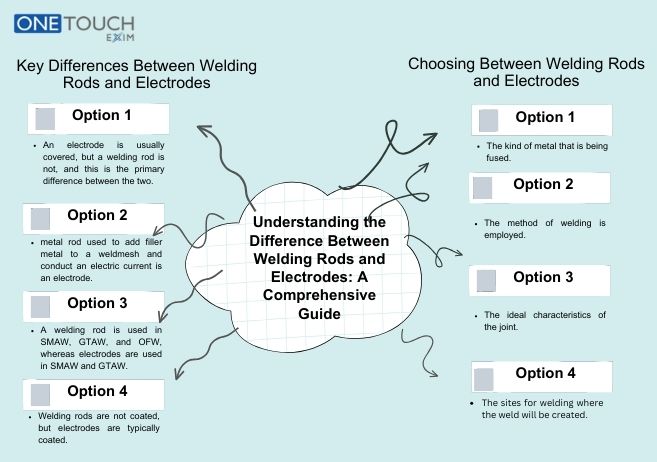The operational process of welding jobs at the commercial level requires structural steel construction or pipe welding. Also, in the industrial or energy sector, the use of welding electrodes is specified in the contract documents and designed welding codes. However, the application of welding electrodes in a repair job or a construction project does not follow the welding codes or the engineer’s explicit instructions. Now it’s up to the welder to select the right welding electrode for the task. In this guide, we will assist you in the selection of the right welding rod or electrode that is best suited for your application. We also explain the special characteristics, applications, and differences between these welding materials. This information will provide essential insights into the world of welding rods and electrodes, whether you are a welding specialist or a beginner. So let’s start with a basic overview of welding rods and electrodes.
What is a Welding Rod?
Welding rods are typically made of bare metal, while electrodes are coated with a flux material. The flux coating helps to protect the weld from atmospheric contamination and produces slag that protects the weld pool from oxidation. Welding rods are used in a variety of welding processes, including Shielded Metal Arc Welding (SMAW), Gas Tungsten Arc Welding (GTAW), and Oxyfuel Gas Welding (OFW). Welding rods are typically made of a variety of materials, including mild steel, stainless steel, aluminum, and nickel alloys. The use of various types of welding rods will depend on the type of metal being welded and the desired properties of the weld.
What is an Electrode?
It is a type of welding electrode in which the electrical conductor is used to establish contact with a semiconductor, electrolyte, vacuum, or air, among other non-metallic components of a circuit. Depending on the type of battery, electrodes—which are crucial components that are made of a wide range of materials. In welding, electrodes serve as conductors between the metals being welded and the welding power source. They generate the necessary heat and current to create an arc, which melts the electrode and forms the weld pool. Electrodes are commonly used in Shielded Metal Arc Welding (SMAW) and Gas Metal Arc Welding (GMAW) processes. They are affordable, easy to use, and suitable for various welding positions. Electrodes find applications in industries such as automotive, aerospace, and medical equipment.
Characteristics of Welding Rod
Welding rods provide benefits as well as drawbacks. They are appropriate for welding thicker materials and offer more control over the weld pool. To get the intended outcomes, though they might need more training and expertise.
Characteristics of Electrode
Electrodes are simple to use and perfect for any position in welding. It is also known by the name of welding electrodes. They are frequently used due to their affordability and work well for welding operations involving thinner materials. Their performance can, however, be greatly impacted by the selection of electrode diameter, coating type, and current requirements.
Applications of Welding Rod
Welding rods are commonly used for pipes, shipyard welding, steel storage tanks, water towers, moderate penetration welding, alternating or direct currents, low to moderate carbon steel welding, high-speed flat or horizontal welds, and other applications using thick metals. They are frequently utilized in the construction and shipbuilding industries. When longevity and structural integrity are crucial, they perform exceptionally well.
Application of Electrodes
Electrodes are primarily used to create electrical current that is then passed through non-metal things to change them in various ways. Conductivity can also be measured with electrodes.
Additional applications consist of different battery types, welding, cathodic protection, membrane electrode assembly, electroplating and electrolysis, chemical analysis, and Taser electroshock weapons, all of which use electrodes. Welding Electrodes are also utilized in defibrillators, ECGs, ECTs, and EEGs in the medical industry. In biomedical research, electrodes are also employed for electrophysiological procedures. Electrodes play a crucial role in industries such as automotive and aerospace.
Welding Rods Vs Electrodes: Quick Overview
| Welding Rods | Electrodes |
| A welding rod is not covered. | An electrode is covered. |
| A metal rod used to add filler metal to a weld mesh is known as a welding rod. | A coated metal rod used to add filler metal to a weldmesh and conduct an electric current is an electrode. |
| A welding rod is used in SMAW, GTAW, and OFW. | Electrodes are used in SMAW and GTAW. |
| Welding rods are not coated. | Electrodes are typically coated. |
Choosing Between Welding Rods and Electrodes
When selecting between welding rods and electrodes, several factors need to be considered. That is:
- The kind of metal that is being fused.
- The method of welding is employed.
- The ideal characteristics of the joint.
- The sites for welding where the weld will be created.
Consulting with a qualified welding instructor or engineer is recommended for making the right choice.
Conclusion
In conclusion, understanding the difference between welding rods and electrodes is crucial for successful welding operations. While welding rods are bare metal rods used as filler material, electrodes are coated with a flux material. The choice between welding rods and electrodes depends on various factors, including the type of metal, welding process, and desired weld characteristics. By considering these factors and seeking professional advice when needed, one can make informed decisions and achieve optimal welding results.
